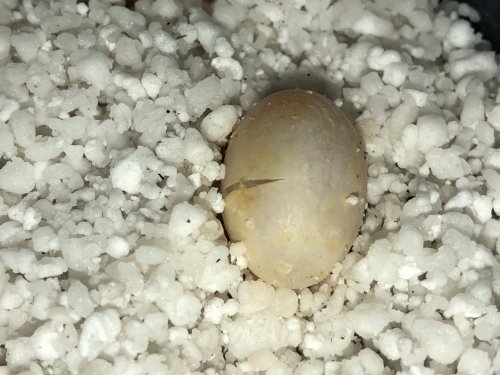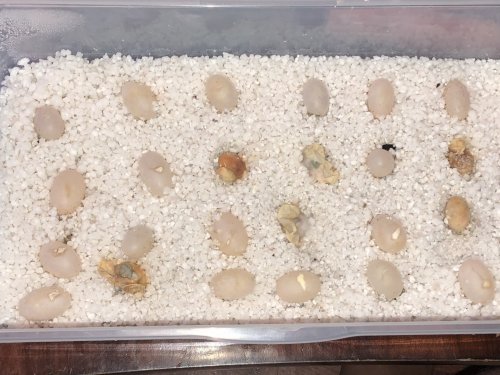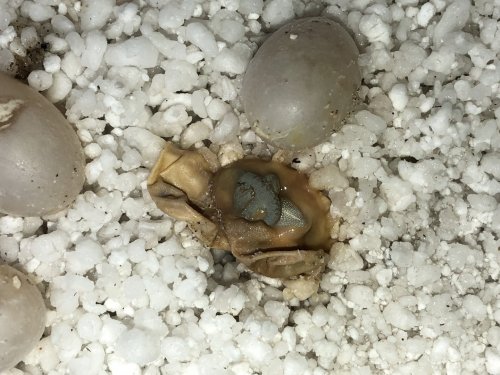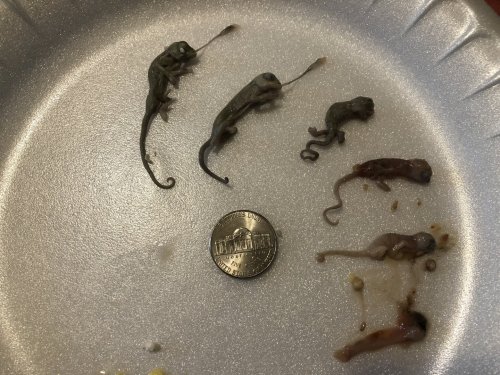Brodybreaux25
Chameleon Enthusiast
So my veilds are finally starting to hatch! But I have two problems. I don’t know when this started due to me working 12 hrs a day for the last 18 days and of the three that hatched none of them made it out of the shell. I don’t know when they started to hatch but it was long enough ago that the dead babies had a bit of white mold on them.
I know your not supposed to help them hatch, the whole survival of the fittest thing, but is there any thing I can do to make it easier for them to escape the shell on their own? Or is it just going to be what it’s going to be at this point?
This is my first hatch so I have no clue what I’m talking about but the ones that have pipped and died all appear to be fully formed and healthy looking. I’m a science nerd so I couldn’t resist taking a closer look at the ones that didn’t make it. Do the bigger ones appear to be normal sized hatchlings? The smaller ones came from eggs that died somewhat recently.
Fair warning, I find the pics below fascinating but if your easily grossed out I suggest you don’t look at these pics.
And the ones with splits, I’m assuming those will be the next to hatch?
I know your not supposed to help them hatch, the whole survival of the fittest thing, but is there any thing I can do to make it easier for them to escape the shell on their own? Or is it just going to be what it’s going to be at this point?
This is my first hatch so I have no clue what I’m talking about but the ones that have pipped and died all appear to be fully formed and healthy looking. I’m a science nerd so I couldn’t resist taking a closer look at the ones that didn’t make it. Do the bigger ones appear to be normal sized hatchlings? The smaller ones came from eggs that died somewhat recently.
Fair warning, I find the pics below fascinating but if your easily grossed out I suggest you don’t look at these pics.
And the ones with splits, I’m assuming those will be the next to hatch?
Attachments
-
 9AB40BD0-0936-4A4A-9E0F-C37BEA5196E9.jpeg276.7 KB · Views: 382
9AB40BD0-0936-4A4A-9E0F-C37BEA5196E9.jpeg276.7 KB · Views: 382 -
 D837A91F-CA27-482B-AB61-215817E848AE.jpeg225.7 KB · Views: 354
D837A91F-CA27-482B-AB61-215817E848AE.jpeg225.7 KB · Views: 354 -
 BDD5503E-4980-4F85-AEDB-2A993C2321A1.jpeg243 KB · Views: 356
BDD5503E-4980-4F85-AEDB-2A993C2321A1.jpeg243 KB · Views: 356 -
 20734366-AB90-4E52-827E-BAF1153F312D.jpeg284.6 KB · Views: 365
20734366-AB90-4E52-827E-BAF1153F312D.jpeg284.6 KB · Views: 365 -
 E43F9B9D-1E16-451D-8D9B-EC99A04FC310.jpeg294.7 KB · Views: 389
E43F9B9D-1E16-451D-8D9B-EC99A04FC310.jpeg294.7 KB · Views: 389 -
 3E100376-5CBD-4AF6-8314-4BA48D9E6F7C.jpeg320 KB · Views: 397
3E100376-5CBD-4AF6-8314-4BA48D9E6F7C.jpeg320 KB · Views: 397 -
 38EBB93B-3DC4-4C0B-B249-65D74943F7D5.jpeg333.8 KB · Views: 361
38EBB93B-3DC4-4C0B-B249-65D74943F7D5.jpeg333.8 KB · Views: 361 -
 E45ED70E-2599-44D7-99DF-C05E715E7CCF.jpeg499.3 KB · Views: 431
E45ED70E-2599-44D7-99DF-C05E715E7CCF.jpeg499.3 KB · Views: 431 -
 59CCD78C-F878-42A2-B627-6B8A71774FA6.jpeg440.4 KB · Views: 484
59CCD78C-F878-42A2-B627-6B8A71774FA6.jpeg440.4 KB · Views: 484




